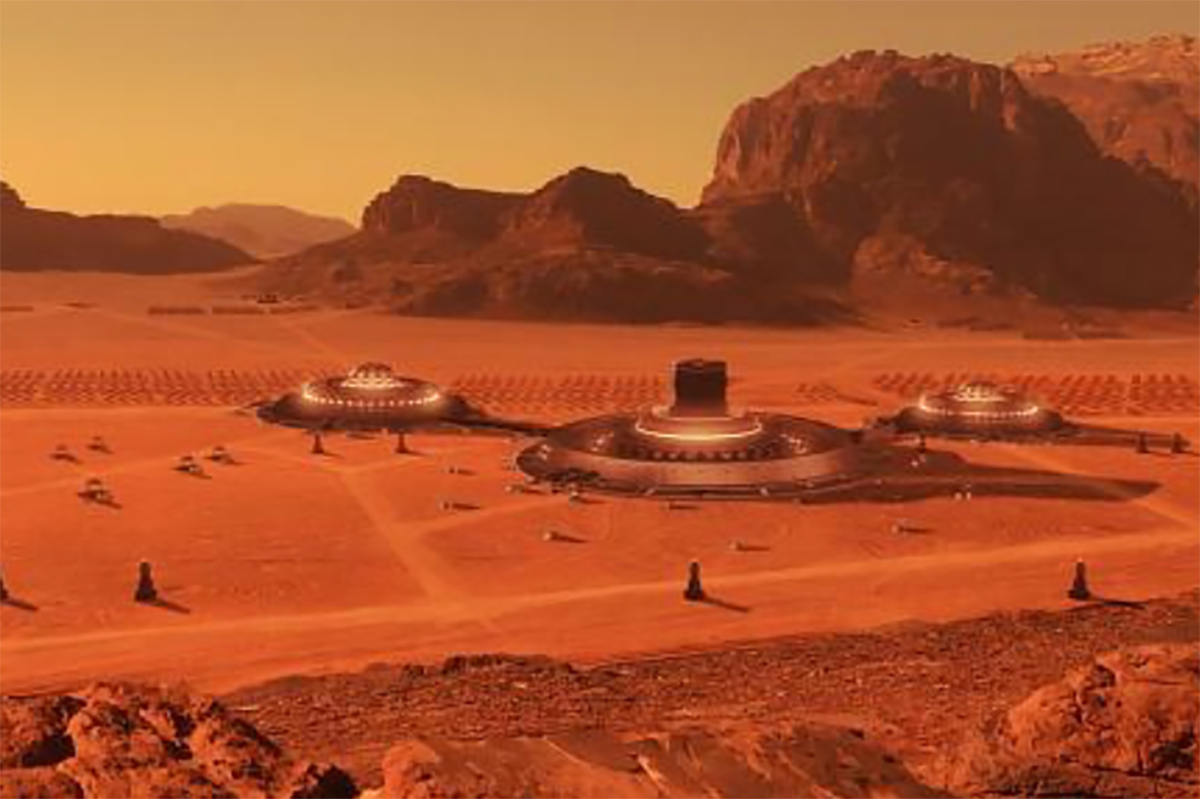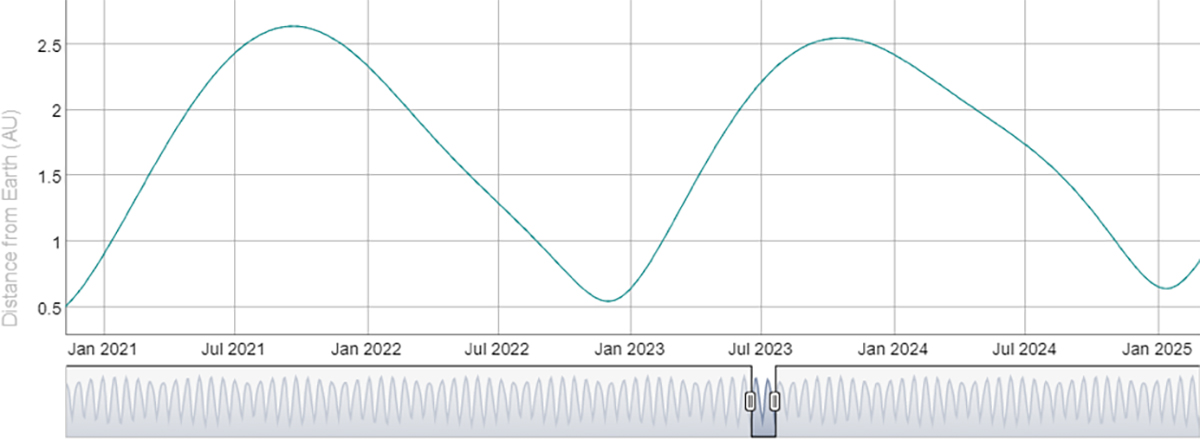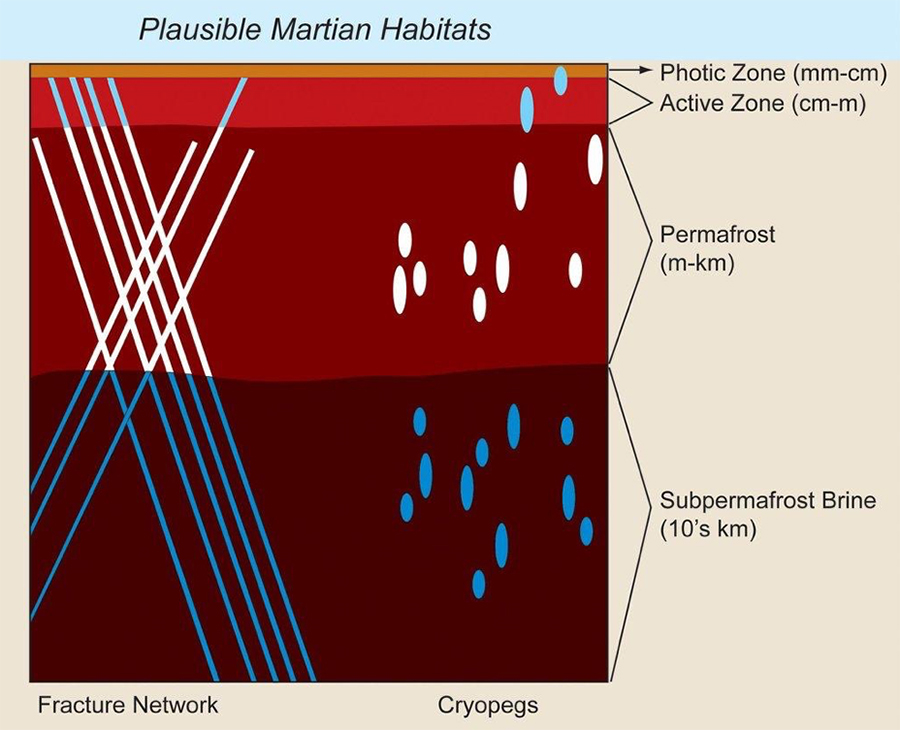of Distance Education on Mars

Due to the tremendous distance between Earth and Mars, the delay in radio communications (at the speed of light) is between 3 and 22 minutes each way as the two planets move through their respective orbits. This then makes the wait to receive a response in two-way communication between 6 and 44 minutes. When it comes to live communication (via text, audio, or video) this means that at best a student on Mars might receive about 60 responses from a teacher in a six hour school day, and at worst no more than 8 responses in a school day. Clearly questions during a live lesson would be impractical. For an asynchronous model where students work independently and send a question when necessary, this might require some patience but should be workable.
However, most asynchronous online programs expect students to read and research independently and any kind of open-ended online research will be similarly frustrating. When Earth and Mars are furthest away a student who performs a search using Google would have to wait 45 minutes to see the results of the search – and another 45 minutes before seeing the first page they click on. Predictive algorithms and local caching might alleviate this to some degree, but any unpredictable or creative lines of inquiry would be painfully impractical.
Even with predictive caching, bandwidth from Earth to Mars and local cloud computing capacity on Mars would also be factors. Currently the bandwidth between Earth and Mars is at most 32 Megabits per second (Mbps), or about 10 percent the capacity of the home Internet connection used when composing this paper on Google Docs. Clearly this will need to be improved by orders of magnitude before Internet use on Mars is viable, especially for media rich experiences of any kind. Information could be cached locally (the entire wikipedia for instance is only 107.5 GB right now and could easily be stored on a single flash drive) but doing this on the scale of the Internet would be an ambitious and resource-heavy project requiring a cloud infrastructure on Mars (mirroring the ones on Earth) for any sort of interactive or collaborative applications like Google Docs for instance. Currently the Perseverance Mars rover uses Earth-based cloud computing instead.
Luckily there are already efforts underway to tackle the need for local cloud computing on Mars and SpaceX has already announced plans to implement Starlink satellites on Mars which should provide a local planetary network with bandwidth of at least 300 to 1000 Mbps. These efforts could be coupled with higher-bandwidth laser-based communication systems between Earth and Mars and may thus make a Martian Internet robust enough for educational needs, including local caches and collaborative cloud computing resources. (Of course, Martian students would still not be able to edit a document live with peers on Earth.)

These silver linings do not alleviate the challenges involved with creating a hands-on learning experience, especially when it comes to physically making things. Ideally a makerspace is a place where students have an opportunity to explore their own interests, learn to use tools and materials both physical and virtual, and develop creative projects. Such spaces are shown to encourage student agency and develop creative competence which students will surely need to survive and thrive on Mars. But such an open-ended space with a variety of tools and materials may be prohibitively resource-intensive for an early space settlement. While a virtual maker space might alleviate this problem to some degree the issues of time delay, bandwidth, and local cloud computing resources would once again come into play; an Oculus headset wouldn’t operate well when it has to wait 45 minutes for a reply from Facebook servers and it couldn’t connect Martian students with peers or experts on Earth in real time any more than a Zoom call or radio could.
Similarly, while virtual socialization can be beneficial for some students in some ways, synchronous interactions are unequivocally important to social development and again wouldn’t be possible except between the limited number of local Martian students. And when it comes to physical education, even students recognize the difficulties inherent in a remote learning scenario. There would be no sports on Mars, at least at first. (Space for athletic facilities or fields would also be an issue for many sports.) That said, physical education over a distance can be beneficial if it de-emphasizes the focus on a “hero athlete” and helps students reflect on their own health instead.
Regardless of physical issues, scheduling would also be a new challenge. Even if students on Mars are able to interact with a teacher on Earth up to 60 times a day asynchronously, the hours of the school day would change for the teacher (presuming they stayed the same for the student). Due to the slightly longer day on Mars, the start time on Earth would shift 37 minutes each day, meaning in less than two weeks the Martian students would be awake during the teacher’s sleep hours and then the start time would continue shifting until it was morning again two weeks later. This problem might be either relieved and/or exacerbated by having teachers in multiple time zones on Earth. In any case, there would also be a question about the academic year; with a Martian year being nearly double the length of an Earth year (687 days), would students on Mars follow Earth’s school calendar regardless of the time of year on Mars? Or would Martian education systems leave K-12 behind for a system of 7 grades (based on local years) that cover the same developmental stages for students?
Perhaps more importantly, how would parent schedules work? If students are primarily interacting with peers and teachers on Earth in a distance learning format, how much of their parents’ time will be required for supervision? This issue was revealed to be a struggle for many families during the COVID-19 pandemic, especially for families with two working parents as all families would almost certainly be in a new Martian settlement. Parents are critical to setting expectations for students, and student supervision requires a lot from parents – so much so that school districts released guidelines for parent’s self care during the pandemic. How compatible would this stress be with the realities of surviving and building a settlement on a forbidding planet? One recent model that might be useful on Mars is the formation of learning “Pods” consisting of a small number of students with a single teacher or parent supervisor. While this has been touted as a potentially revolutionary micro schooling model in the wake of the pandemic, it doesn’t address the fundamental childcare problem that traditional schools also solve. At least some subset of Martian parents would need to be on hand to supervise and assist the pod of students. (This could happen in a co-op fashion where parents take turns supervising, but this might not be what’s best for students who need competent support.)

Quantum communication might be held up as a possibility for improving the bandwidth between Earth and Mars, if not potentially eliminating the lightspeed dependent delay altogether. Quantum communication is mostly used for encryption purposes today but might also increase the efficiency of communication in deep space. In fact, communication networks on Mars (and between planets) may look very much like the CubeSat Quantum Communications Mission (CQuCoM) of today. But because of the need for laser (or radio) to transmit the information necessary to compare states of entangled qubits, even quantum communication (as it is understood today) will not be able to overcome the transmission delay due to the speed of light. That said, these avenues of research may turn up surprising new opportunities and questioning physical limits can be a powerful tool for scientific progress; scientists should “never say never.”
Meanwhile, it seems the first education system setup on Mars will require a great deal of planning ahead, acceptance of asynchronous communication methods, and (most of all) significant reservoirs of patience. But this is no more than was required of pioneers and settlers in earlier periods of human history when messages might take months to cross an ocean by boat.
So while the delay in communication, the difficulty in providing collaborative hands-on learning experiences and the issues related to scheduling (not to mention the related technical challenges) might be significant, these are all factors that can be addressed with planning. Local infrastructure, best practices for asynchronous learning coupled with the best of micro schooling pods, and judicious use of emerging technologies (like VR, AI, and whatever quantum communication may offer in the coming years) can all help to alleviate the challenges of establishing the first education system on Mars even for very small numbers of students in the earliest settlements. Once again planning, patience, and creative problem solving will open up new possibilities in human history.
About the author
Mark Wagner has a Ph.D. in Educational Technology and a masters degree in Cross-Cultural Education. He also holds graduate certificates in Space Education and Space Philosophy. He is the author of More Now: A Message from The Future for The Educators of Today (2018) and Space Education: Preparing Students for Humanity’s Multi-Planet Future (2022), which explores both the current reality on Earth and the possibilities for teaching students on the Moon, on Mars, and in deep space habitats.